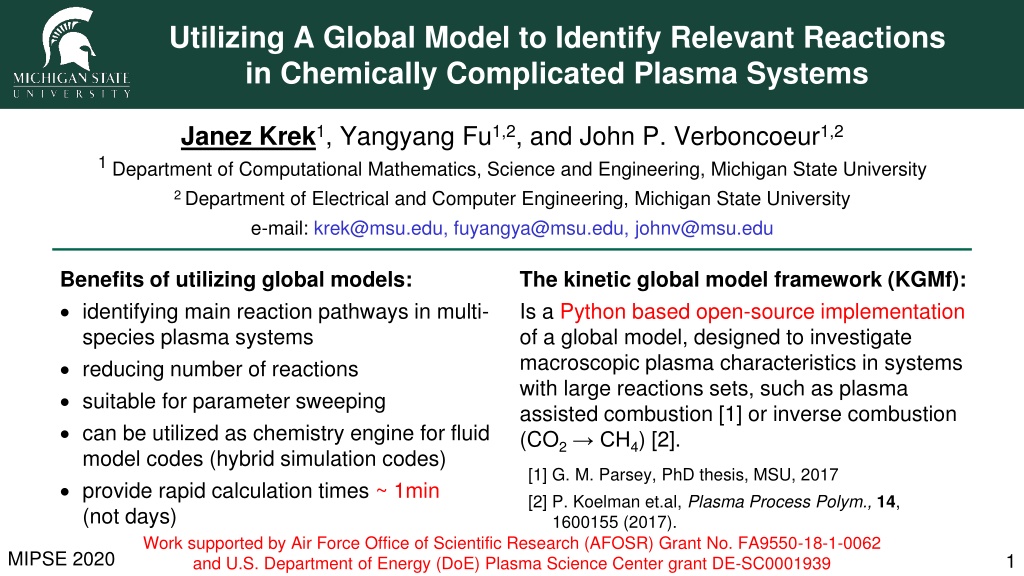Utilizing a Global Model for Analyzing Reaction Pathways in Plasma Systems
This research focuses on using a kinetic global model framework to identify relevant reactions in chemically complex plasma systems. The framework, KGMf, enables the investigation of macroscopic plasma characteristics by analyzing reaction pathways, sensitivity to reaction rate errors, and dominant reaction pathways. By reducing the number of reactions and providing rapid calculation times, this approach offers insights into main reaction pathways in multi-species plasma systems. Supported by grants from the Air Force Office of Scientific Research and the U.S. Department of Energy, the KGMf approach has the potential to advance our understanding of plasma-assisted combustion and other plasma applications.
Download Presentation

Please find below an Image/Link to download the presentation.
The content on the website is provided AS IS for your information and personal use only. It may not be sold, licensed, or shared on other websites without obtaining consent from the author. Download presentation by click this link. If you encounter any issues during the download, it is possible that the publisher has removed the file from their server.
E N D
Presentation Transcript
Utilizing A Global Model to Identify Relevant Reactions in Chemically Complicated Plasma Systems Janez Krek1, Yangyang Fu1,2, and John P. Verboncoeur1,2 1 Department of Computational Mathematics, Science and Engineering, Michigan State University 2 Department of Electrical and Computer Engineering, Michigan State University e-mail: krek@msu.edu, fuyangya@msu.edu, johnv@msu.edu Benefits of utilizing global models: identifying main reaction pathways in multi- species plasma systems reducing number of reactions suitable for parameter sweeping can be utilized as chemistry engine for fluid model codes (hybrid simulation codes) provide rapid calculation times ~ 1min (not days) Work supported by Air Force Office of Scientific Research (AFOSR) Grant No. FA9550-18-1-0062 and U.S. Department of Energy (DoE) Plasma Science Center grant DE-SC0001939 The kinetic global model framework (KGMf): Is a Python based open-source implementation of a global model, designed to investigate macroscopic plasma characteristics in systems with large reactions sets, such as plasma assisted combustion [1] or inverse combustion (CO2 CH4) [2]. [1] G. M. Parsey, PhD thesis, MSU, 2017 [2] P. Koelman et.al, Plasma Process Polym.,14, 1600155 (2017). MIPSE 2020 1
1. Identify Relevant Reactions with the KGMf Approach depends on desired results: Sensitivity analysis of the species densities on reaction rate errors (cross sections or rate coefficients). KGMf KGMf KGMf KGMf ?? ?? ?? ?? ?? ?? KGMf Contribution of reactions on creation/destruction of species (dominant reaction rate pathways analysis Koelman et.al [3], PumpKin[4]). Reaction number reduction PumpKin KGMf KGMf Flowchart from [1] [3] P. Koelman et.al, Plasma Sources Sci. Technol., 28, 75009 (2019). [4] A.H. Markosyan, Comput. Phys. Commun., 185, 2697 (2014). MIPSE 2020 2
2. PumpKin define dominant reaction pathways Dominant pathways are defined by PumpKin (pathway reduction method for plasma kinetic models) [4] The dominant pathways are based on branch points (defined based on lifetime of species). Reversed reactions from the KGMf are separated into forward and backward reaction. Input Parameters: list of species and reactions time evolution of system parameters (species densities and temperatures) time evolution of reaction rates stoichiometric matrix Results (output): Reaction pathway with their contribution to generation / destruction of species ?1 ?2 ?? ?1:?% ?2:?% ??:< ?% PumpKin KGMf KGMf ?? Results Results compare (Full reaction set) (Reduced reaction set) [4] A.H. Markosyan, Comput. Phys. Commun., 185, 2697 (2014). MIPSE 2020 3
3. Results: nanosecond pulse discharge in O2 Ar (Winters [5]) O2 Ar nanosecond pulse discharge case 1%O2 Ar gas mixture 31 species and 74 reactions global (0D) model deposited energy: 4.2mJ/pulse constant pressure: p = 300 Torr, initial gas temperature: Tg = 500 K volume: 10cm3, 6.5 x 1.5 x 1cm (L x W x H) EEDF: Maxwellian Results: species of interest: O run time: ~180s/run ~4h 30min In parallel on 10 cores ~45min Sensitivity to 20% uncertainty in reaction rate coefficients (K) Running parameters (SA): rate uncertainties: 20% number of runs: 149 (= 1 + 2 x 74) # time steps: 95091 tend = 0.5ms (10 pulses) Combined effect on O density Minimum Maximum R40: Ar + e Ar*+ e +20% -20% R41: Ar + e Ar**+ e -20% +20% R42: Ar + e Ar++ e + e +20% -20% -26.1% +30.5% R22: O2+ e O2*4+ e +20% -20% [5] C. Winters et.al, J. Phys. D: Appl. Phys., 51, 015202 (2018). R21: O2+ e O2*3+ e +20% -20% MIPSE 2020 4
Nanosecond pulse discharge in O2 Ar (reduced reaction set) Reduced reaction set for O density The dominant reactions defined by PumpKin were used to in reduced reaction set and the time evolution of H density compared to full reaction set. Reduced set includes reactions that contribute at least 10% to the creation or destruction of individual species. Reaction set: full reduced # of species # of reactions Running time [s] 31 74 180 15 26 64 Result: The reduced set can capture the time evolution of O density and the difference between reaction sets is getting smaller with increasing time. MIPSE 2020 5
4. Conclusions and future work Conclusions: Performing a sensitivity analysis with the KGMf is simple, defining dominant reactions is mainly a manual work (preparation of a reduced reaction set simulation case). The accuracy of the reduced reaction set highly depend on individual case; in some cases (H2-Ar) it can capture the trend of time evolution of target species density, but the difference compared to the full reaction set is huge. PumpKin is an efficient tool to extract contributions of reaction pathways to species densities (production/consumption of species), but additional check is necessary before using dominant reactions in reduced reaction sets. Future work: Validation of dominant reaction pathway results with KGMf-PumpKin. Automatization of processing of results from PumpKin. Identify dominant reaction pathways in simulations with coupled BE solver. Reducing the overall running time with coupled BE solver, coupling with BOLSIG+/MCIG. MIPSE 2020 6






















